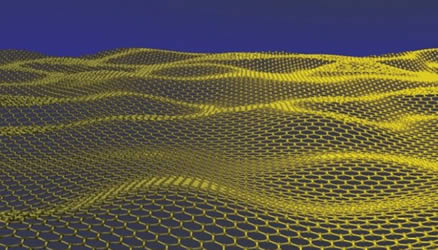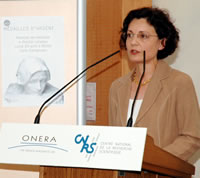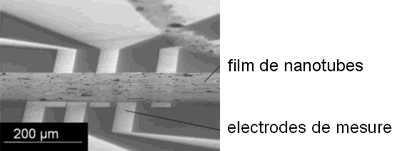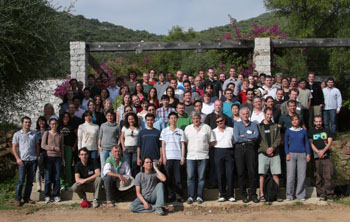Graphene, a sheet of carbon an atom thick, has recently been recognized by the 2010 Nobel Prize for Physics. Annick Loiseau reviews the research at Onera on this revolutionary material.

Artist’s view of a sheet of graphene (Jannick Meyer, University of Vienna, Austria)
InterviewWhat is graphene? |
|
|
Annick Loiseau : It is a sheet of carbon atoms, linked together in hexagons, like a honeycomb. When these sheets are stacked we get graphite, the material in our pencil leads. Carbon nanotubes, very fine threads of carbon of a few nanometers (billionths of a meter) in diameter, are rolled sheets of graphene. Carbon nanotubes have already provoked a lot of research, and this is even more the case with graphene. It should be said that the work on nanotubes has also been a preparation for that now being done on graphene: the theoretical tools, investigative methods and skills acquired on nanotubes can be used for graphene. |
 Annick Loiseau, director of research at Onera, president of the International research group on Graphene & Nanotubes |
| Why is there such interest in this material? | |
| AL. : Firstly, graphene is of great theoretical interest for physicists. It is a purely two-dimensional material (virtually without thickness), with a very special physical composition. It is the first time that we have an object with which we can run experiments and test our theories on two-dimensional objects. Graphène also has numerous properties which make it very promising |
|
|
for applications. Its mechanical qualities first: mechanically, it is both resistant and flexible to such a degree that it can be easily modeled. But it is above all its electrical and magnetic properties that have provoked such enthusiasm from researchers. Graphene is a semi-metal that can be “adulterated” (adding or removing electrons to change its properties) to turn it into a semi-conductor, like silicon in electronic computer circuits. We can also play with the nature of the substrate on which it is deposited to modify the electronic properties. There is going to be a learning curve: researchers have to work on its forming in order to control its properties. The research is already progressing quickly, particularly on the manufacture of nanotubes. The Nobel Prize winners' method is not suitable for applications but other teams have developed methods that can be used to build graphene on larger surfaces. What research is being done at Onera on graphene? AL : We have been working on nanotubes for almost 15 years and so we have of course been interested in graphene, since 2002, but graphene wasn’t very fashionable and we had a great deal of difficulty in publishing our work. At a theoretical level we have done preliminary work on the growth of graphene. We are interested in how the carbon organizes itself on a metal surface, and we have shown that, depending on the conditions, it forms nanotubes or graphene. Being able to control the growth of graphene is fundamental for applications. In terms of work on applications, for the last four years we have been using nanotubes and graphene to develop gas sensors. The electronic properties of these materials are sensitive to their environment. So, when a molecule is absorbed on some graphene or a nanotube, it modifies its electronic properties. We can use this to detect the molecule, with a great deal of sensitivity: we can distinguish one molecule from a billion others. We have developed a gas detection measurement bench that even works at variable temperature and in a humid environment. It is very effective for molecules containing nitrogen, which is the case with a lot of pollutants. Onera is also working on infrared detection, which involves optics work at the nanometric scale [1]. Graphene may be able to play a role here, but we have only just started this work.
[1] See The second youth of optics at www.onera.fr 2010 Nobel Prize for Physics for work on graphene The Nobel Prize for Physics has recently been awarded to Andre Geim and Konstantin Novoselov, of the University of Manchester in Great Britain for "their revolutionary experiments on a two-dimensional material, graphene. They were the first to isolate, identify and characterize a single layer of carbon atoms, called graphene", stated the Nobel Committee. They developed a method by using.... a simple piece of adhesive tape. They stuck this to very pure graphite and then pulled off several layers of graphene. By folding the tape back onto itself several times the number of layers can be reduced. When the tape is dissolved it is possible to recover parts made up of a single layer of graphene, but there will also be thicker parts. Then there is the fastidious work of sorting, under the microscope, to only keep the single layers. Geim and Novoselov, now aged 51 and 36, were also able to identify the extraordinary properties of graphene. Their method of obtaining the material, very improvised, won’t be how this will be done for applications. But it does now mean that thousands of researchers will be able to make further advances in our knowledge of graphene.
When researchers get together Annick Loiseau leads the Research Group (GDR) on nanotubes and graphene, created by the National Scientific Research Center (CNRS) in 2009, created out of the GDR on nanotubes, at a national level in 1998 and then extended internationally in 2005. The objective: to promote exchanges and joint work between researchers in order to structure their research. “This group has created a real solid international scientific community, with a lot of added value in comparison with standard partnerships: the training of researchers, help for joint work and exchanges between teams, sharing of knowledge, thorough discussions at conferences, the organization of thematic schools for young researchers, international conferences and workshops, help for students so they can attend conferences and promote their work, etc." according to those running it. So this GDR is creating a real scientific community, indispensable if progress on this type of work is going to be made quickly. More than 60 laboratories are contributing to this GDR, from France and also Belgium, Canada, Spain, Germany, the United Kingdom, etc. Graphene specialists in Corsica The nanotubes and graphene research group, lead by Annick Loiseau, organized the first Research theme school on graphene at the Scientific Studies Institute at Cargese in Corsica, from 12th to 22nd October 2010. It brought together 80 participants, essentially postgraduates and postdoctorands, as well as twenty or so contributors who are international specialists at the forefront in this field. At this conference we heard one of the Nobel Prize winners, Konstantin Novoselov, and also Walt de Heer, whose group developed a method of making graphene that can be industrialized almost at the same time as Novoselov and Geim, and Philippe Kim. This School reviewed the current knowledge of graphene, and also the research and applications to come.
Interview conducted by Cécile Michaut, scientific journalist |
|



![Image de microscopie tunnel d'une feuille de graphène fabrisur un substrat de céramique (SiC) [Source: Institut Néel, CNRS Grenoble]](/sites/default/files/actualites/magazine/parole_de/2010-10-19-graphene-sic.gif)





